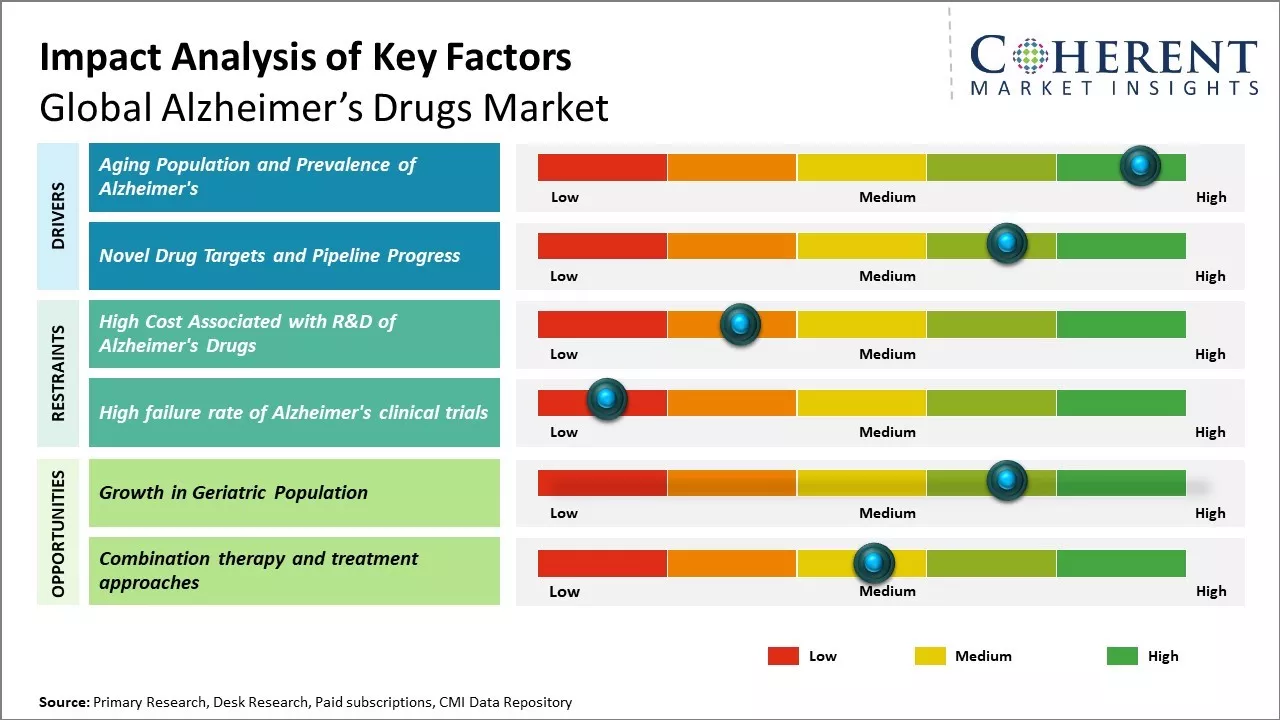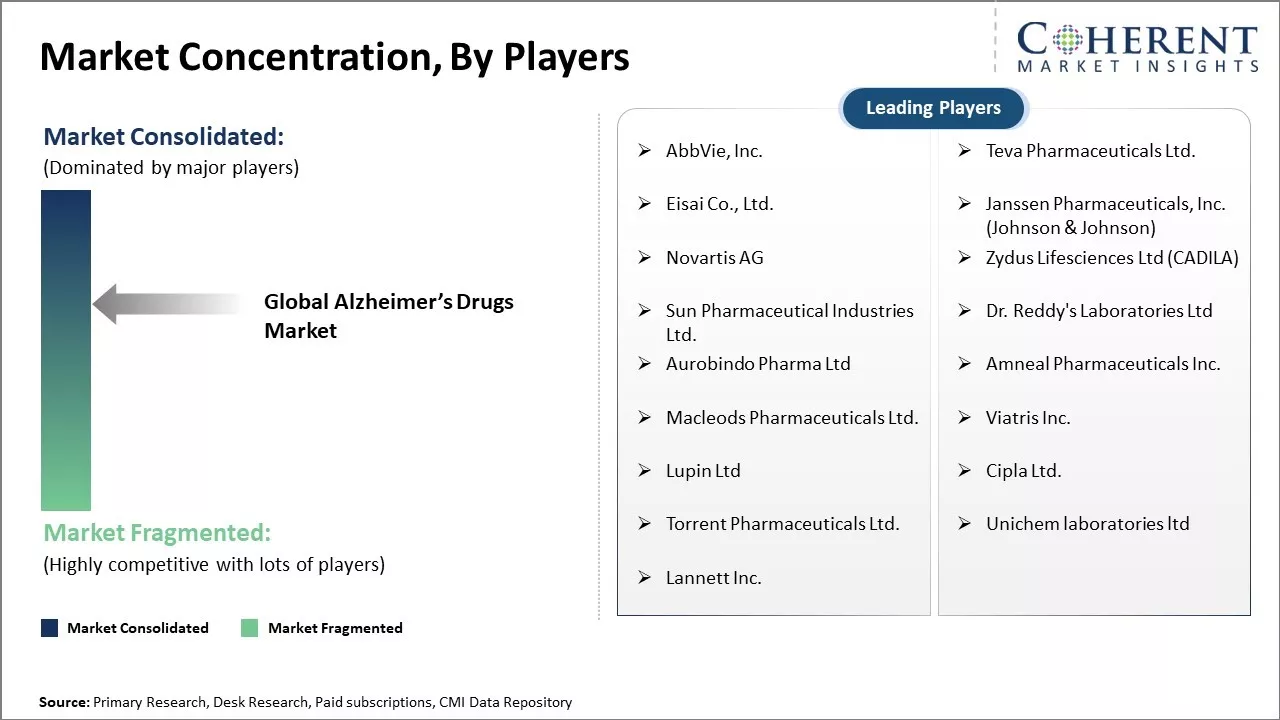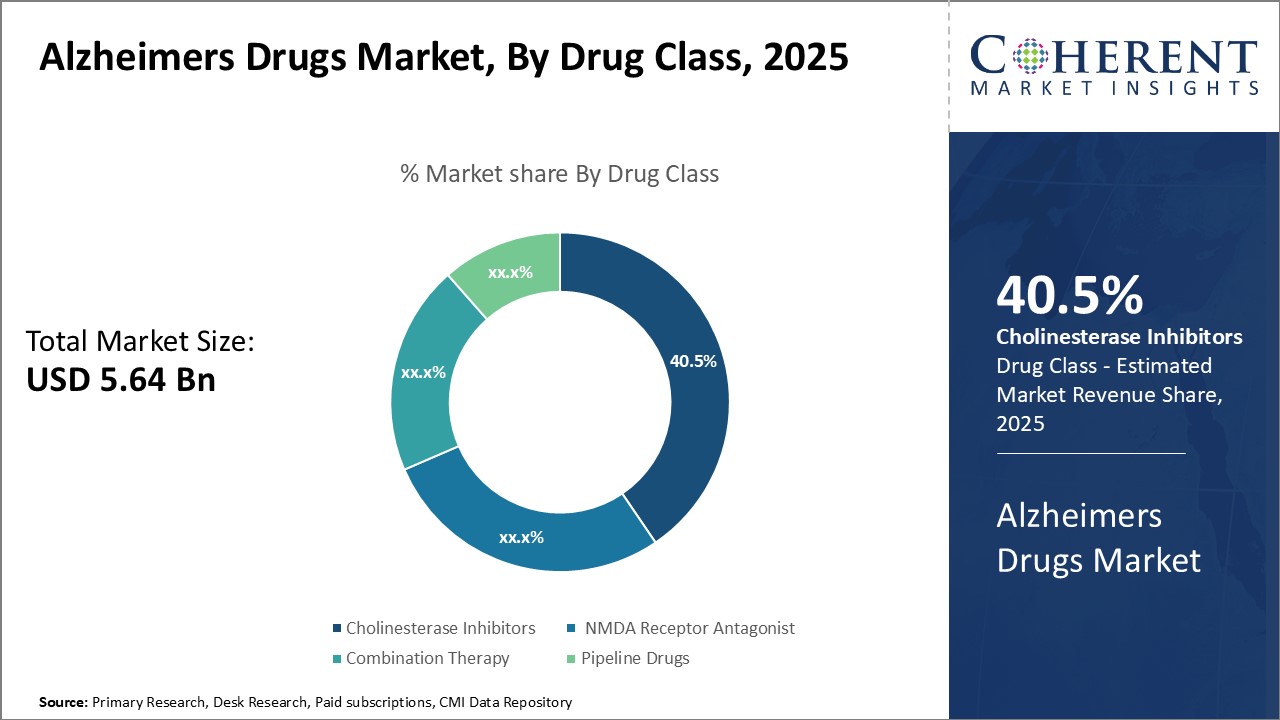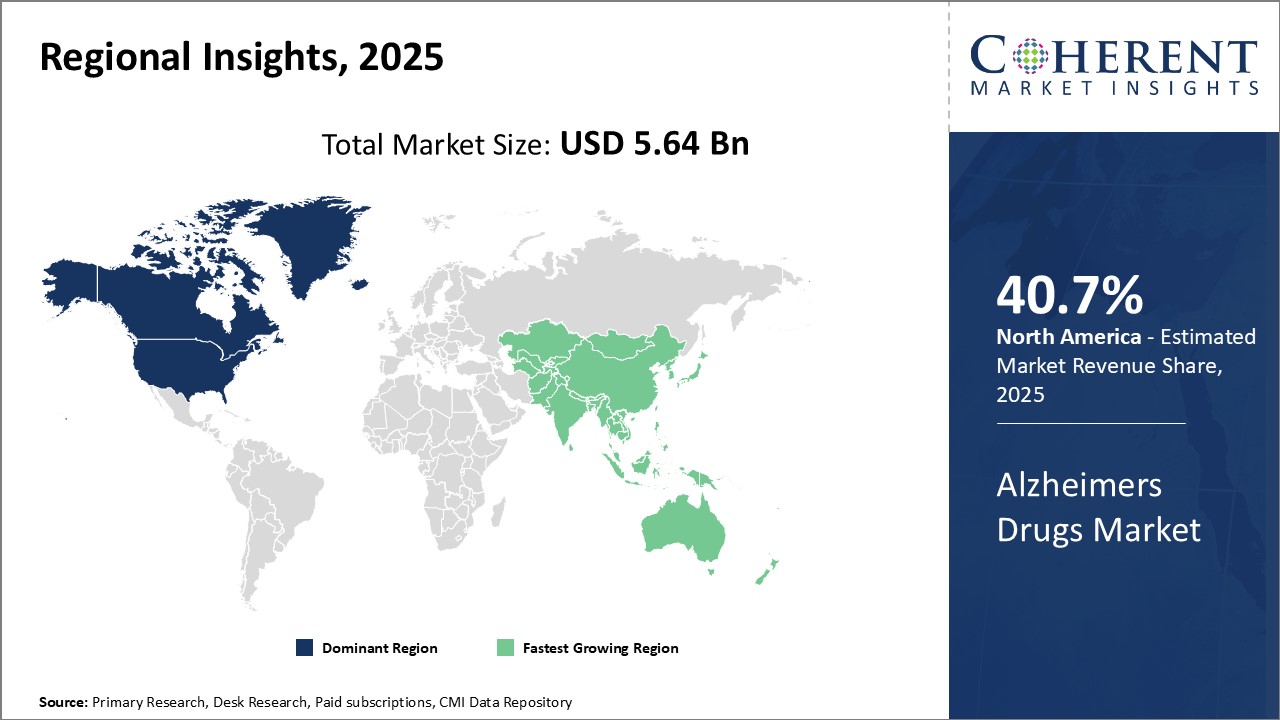Global Alzheimer’s drugs market is estimated to be valued at USD 5.64 Bn in 2025 and is expected to reach USD 11.34 Bn by 2032, exhibiting a compound annual growth rate (CAGR) of 10.5% from 2025 to 2032.

Discover market dynamics shaping the industry: Request sample copy
Global Alzheimer’s drugs market growth is driven by increasing incidence and prevalence of Alzheimer’s disease worldwide due to rising geriatric population. New product launches by key players can also drive the market growth. The launch of new drugs that target the underlying causes and slow disease progression rather than just control symptoms can drive the market growth. However, patent expiry of blockbuster drugs, high costs associated with drug development and lack of curative drugs ar can hamper the market growth during the forecast period.
Aging Population and Prevalence of Alzheimer's
Due to rising life expectancy, there has been increase in number of elderly people aged 65 years and over. According to WHO, the proportion of the world's population over 60 years will nearly double from 12% to 22% between 2015 and 2050. Elderly population is particularly susceptible to neurodegenerative conditions such as Alzheimer's and dementia due to natural age-related cognitive decline. Alzheimer's disease is the most common cause of dementia among older adults. As more people survive into their 80s and beyond, even a small increase in diagnosis rates in the very old can cause a dramatic rise in prevalence numbers. In 2017, according to a report, around 50 million people have dementia worldwide, and Alzheimer's disease accounts for 60–70% of cases. Growing elderly populations can increase Alzheimer's cases without effective prevention or cure strategies.

Get actionable strategies to beat competition: Request sample copy
Novel Drug Targets and Pipeline Progress
After multiple past failures in treatment development for Alzheimer's, the currently approved medicines can only manage symptoms temporarily without altering disease progression. There has been promising pipeline activity that explores novel mechanisms and molecular targets beyond the amyloid hypothesis. Several companies are developing disease-modifying drugs targeting tau tangles, neuroinflammation, synaptic dysfunction, and other pathways increasingly implicated in Alzheimer's pathology. Large late-stage trials are ongoing to evaluate anti-amyloid antibodies as well as anti-tau antibodies and small molecules for preventing or slowing cognitive decline. Some potential first-in-class therapies for early Alzheimer's include anti-Tau antibody crenezumab from Genentech and anti-amyloid gamma secretase modulator verubecestat from Merck.
Key Takeaways from Analyst
With aging global population and increasing prevalence of dementia worldwide, the addressable patient pool for Alzheimer's treatments will expand significantly. Meanwhile, growing awareness about the condition and its impact drive more patients and caregivers to opt for pharmaceutical treatment options. However, current treatment options only provide temporary symptomatic relief without modifying disease progression. The high failure rate of drugs in late-stage clinical trials indicates the complexity of the condition and the urgent need for more effective therapies. High research and development costs associated with Alzheimer's drug development can deter many pharmaceutical companies. Large unmet need and lack of effective therapies mean there is room for novel drugs that can meaningfully slow or stop disease progression. Asia Pacific is expected to be the fastest growing region due to aging demographics in China and Japan. Furthermore, increasing focus on biomarkers may help streamline clinical trials and boost success rates. If targeted drugs targeting specific causes can be successfully developed, it would unlock far greater market potential globally.
Market Challenges: High Cost Associated with R&D of Alzheimer's Drugs
Global Alzheimer's drugs market growth can be hampered by extremely high cost associated with research and development of new drugs for this disease. Alzheimer's is a complex disorder with an unknown cause and unclear pathogenesis. Developing effective drugs requires huge investments in basic research to understand the disease mechanism first, followed by lengthy and expensive clinical trials. Since currently approved drugs only provide modest symptomatic benefits and do not slow progression, pharmaceutical companies have struggled to recoup their R&D costs through sales of these drugs. This high risk and uncertainty poses a significant hurdle for pharma companies and deters much needed investments in Alzheimer's drug innovation. Unless ways are found to share costs and risks across stakeholders, or returns are improved through premium pricing, this challenge will hamper growth of the Alzheimer's drugs market.
Market Opportunities: Growth in Geriatric Population
Growth of geriatric population worldwide can offer opportunities for the Alzheimer's drugs market growth. Alzheimer's is a disease that affects older adults, with risks rising sharply after age of 65. As average lifespans increase across both developed and developing nations, there will increase in number of people aged 65 years and over. Since elderly population is the primary patient segment, any growth in this demography directly translates to a larger potential patient pool for Alzheimer's drugs. If effective treatments become available that can delay onset or slow progression of the disease, the Alzheimer's drugs market will be well poised to tap into this expanding pool of elderly patients. Industry players should focus on addressing the needs of an aging society to capitalize on this opportunity for future market growth.

Discover high revenue pocket segments and roadmap to it: Request sample copy
By Drug Class- Meeting Unmet Needs
In terms of drug class, cholinesterase inhibitors segment is estimated to contribute the highest market share of 40.5% in 2025, owing to its ability to meet significant unmet needs. Cholinesterase inhibitors work by increasing levels of a chemical messenger in the brain called acetylcholine, which can help slow decline in thinking skills, memory and other functions. These are some of the first treatments approved specifically for Alzheimer's disease and remain a core therapeutic option for many patients. The mechanism of action targeting acetylcholine neurotransmission addresses a key pathological process in Alzheimer's and provides symptomatic benefit. Cholinesterase inhibitors offer oral administration convenience as compared to other treatment approaches in development. The efficacy demonstrated on cognitive and functional outcomes has led to their widespread adoption as the frontline pharmacotherapy for mild-to-moderate Alzheimer’s disease. Growing aging population and rising incidence of Alzheimer's can boost need for disease-modifying and neuroprotective strategies. Cholinesterase inhibitors currently satisfy an important treatment need until superior alternatives emerge from the pipeline to target the underlying disease pathology more directly.
By Route of Administration- Maximizing Patient Adherence
In terms of route of administration, oral segment is estimated to contribute the highest market share of 58.5% in 2025, owing to its advantage of maximizing patient adherence to treatments. For most Alzheimer's patients in the mild-to-moderate stages of the disease, oral administration of medicines is preferred as it is non-invasive and can be self-administered at home without need for clinic visits. The convenience of oral dosing encourages compliance with the treatment regimen over an extended period of time that may span years. This is critically important for Alzheimer's where continuous management is required as symptoms progress. Any new therapeutic approach introduced must demonstrate at least comparable, if not improved, tolerability and adherence-enhancing properties to gain patient acceptance and market share over existing oral options. Administering medicines orally also avoids introduction of potential infection risks as compared to parenteral routes and additional cost burdens to healthcare systems as compared to injection administration. Positive effects on cognition and function rely upon consistent intake of therapies as prescribed over the long term.
By Distribution Channel- Reinforcing Care Models
In terms of distribution channel, hospital pharmacies segment is estimated to contribute the highest market share of 45.5% in 2025, owing to its role in reinforcing integrated care models for Alzheimer’s patients. Alzheimer's treatment necessitates a multidisciplinary approach beyond just pharmacotherapy alone. Optimal management involves pairing pharmaceutical interventions with counselling, therapies, and community support services tailored to patients and their caregivers. Hospital pharmacies play a central part in coordinating the delivery of comprehensive Alzheimer's care. These work closely with memory clinics, geriatric specialists, nursing staff and social workers to ensure medications are prescribed appropriately and patients transition smoothly between inpatient and outpatient settings as their needs change. Many hospitals also run specialized dementia day programs, providing therapy and respite to delay nursing home placements. The hospital pharmacies acts as an anchor, supporting a holistic care model where medication optimization occurs in the context of multifactorial assessment and non-drug interventions. This reinforces positive health outcomes and quality of life for individuals coping with progressive cognitive and functional impairment from Alzheimer’s disease.

Need a Different Region or Segment? Customize now
North America dominates global Alzheimer's drugs market with an estimated market share of 40.7% in 2025. The region accounts for the largest market share due to presence of major pharmaceutical companies undertaking research and clinical trials for new drugs. Furthermore, aging population and rising prevalence of Alzheimer's disease in the region also drives the market growth. Countries like U.S. have also approved use of several disease-modifying drugs under their regulatory pathways, thus, providing boost to regional sales.
Asia Pacific region has emerged as the fastest growing market for Alzheimer's drugs. Asia Pacific market is expected to witness highest CAGR, owing to increasing focus of international drug makers to tap unmet needs. Countries like China and India are proving lucrative with their huge patient pool and growing healthcare expenditure. Local companies are also ramping up their R&D activities in collaboration with global innovators. This has led to higher availability of both generic and patented drugs across major Asian countries. Lack of stringent regulations compared to Western nations makes Asia Pacific region an attractive destination for clinical trials of new molecules.
Alzheimers Drugs Market Report Coverage
| Report Coverage | Details | ||
|---|---|---|---|
| Base Year: | 2024 | Market Size in 2025: | USD 5.64 Bn |
| Historical Data for: | 2020 To 2024 | Forecast Period: | 2025 To 2032 |
| Forecast Period 2025 to 2032 CAGR: | 10.5% | 2032 Value Projection: | USD 11.34 Bn |
| Geographies covered: |
|
||
| Segments covered: |
|
||
| Companies covered: |
AbbVie, Inc., Teva Pharmaceuticals Ltd., Eisai Co., Ltd., Janssen Pharmaceuticals, Inc. (Johnson & Johnson), Novartis AG, Zydus Lifesciences Ltd (CADILA), Sun Pharmaceutical Industries Ltd., Dr.Reddy's Laboratories Ltd, Aurobindo Pharma Ltd, Amneal Pharmaceuticals Inc., Macleods Pharmaceuticals Ltd., Viatris Inc., Lupin Ltd, Cipla Ltd., Torrent Pharmaceuticals Ltd., Unichem laboratories ltd, Lannett Inc. |
||
| Growth Drivers: |
|
||
| Restraints & Challenges: |
|
||
Uncover macros and micros vetted on 75+ parameters: Get instant access to report
*Definition: Global Alzheimer's drugs market consists of pharmaceutical drug therapies that are used for treating patients suffering from Alzheimer's disease. These drugs aim to temporarily slow down the progression of dementia symptoms by targeting neurotransmitters in the brain like acetylcholine and glutamate. Some of the drugs include cholinesterase inhibitors, NMDA receptor antagonists, and others. The market has seen significant growth in recent years due to the increasing prevalence of Alzheimer's disease worldwide.
Share
Share
About Author
Ghanshyam Shrivastava - With over 20 years of experience in the management consulting and research, Ghanshyam Shrivastava serves as a Principal Consultant, bringing extensive expertise in biologics and biosimilars. His primary expertise lies in areas such as market entry and expansion strategy, competitive intelligence, and strategic transformation across diversified portfolio of various drugs used for different therapeutic category and APIs. He excels at identifying key challenges faced by clients and providing robust solutions to enhance their strategic decision-making capabilities. His comprehensive understanding of the market ensures valuable contributions to research reports and business decisions.
Ghanshyam is a sought-after speaker at industry conferences and contributes to various publications on pharma industry.
Missing comfort of reading report in your local language? Find your preferred language :
Transform your Strategy with Exclusive Trending Reports :
Frequently Asked Questions
Joining thousands of companies around the world committed to making the Excellent Business Solutions.
View All Our Clients
US Reciprocal Tax Impact Analysis On Alzheimers Drugs Market
Stay updated on tariff changes with expert insights and timely information